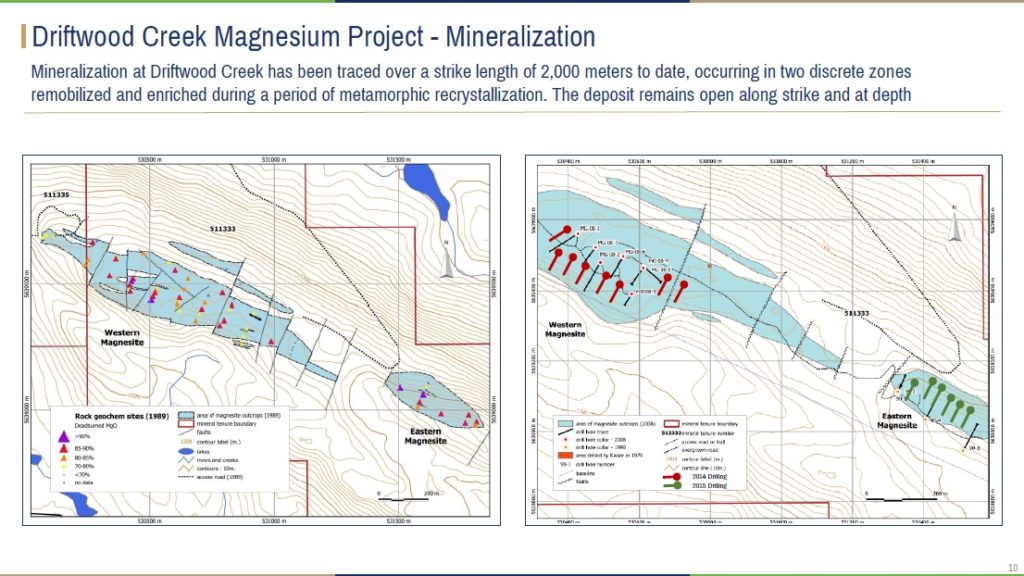MGX Minerals, sponsor of the cover of the March issue of International Mining magazine and featured in the water management article therein, reports a positive PEA on its Driftwood Creek magnesium project. The PEA study was prepared by AKF Mining Services, Tuun Consulting and Samuel Engineering. It assumes a conventional quarry pit operation with a process plant and a furnace/kiln combination to produce a saleable Dead burn magnesium oxide (DBM) product. The plant will also have the ability to produce Caustic-calcined magnesium oxide (CCM) as a separate saleable product. Highlights:
• Pre-tax NPV@5% of $529.8 million, IRR of 24.5% with a 3.5-year payback
• Post-tax NPV@5% of $316.7million, IRR of 19.3% with a 4.0-year payback
• Initial capital costs of $235.9 million (Total life-of mine (“LOM”) – $239.8 includes sustaining/closure costs of $3.9 million and contingency costs of $40.0 million)
• Conventional quarry pit mine with a 1200 tonne per day (“tpd”) process plant using conventional crushing, grinding, flotation upgrading, calcination, and sintering to produce a saleable DBM product
• Cash costs of $350/tonne MgO
• All-in sustaining costs (“AISC”) of $351/tonne MgO
• Average annual MgO production of 169,700 tonnes during an 19 year mine life
• LOM average head grades of 43.27% MgO
• LOM MgO recoveries of 90%
• LOM strip ratio of 2.4 to 1 of rock to mineralized material
“We are extremely pleased with results of the PEA, which display Driftwood’s ability to become a high-margin, low-cost producer of magnesium oxide in a politically secure jurisdiction,” stated MGX President and CEO Jared Lazerson. “We believe this significant milestone outlines a clear path forward and provides numerous opportunities to further enhance the economics of the project with a pre-feasibility study.”
The Driftwood Creek project is located in southern British Columbia, Canada. The mine site property is located approximately 210 km northwest of Cranbrook, BC. Infrastructure currently exists in the form of paved highways and forest service roads, a CPR spur line (at Brisco, BC), and a major power line within 15 km of the property. The plant will be located in Cranbrook, BC, to where all mineralised ROM material will be hauled and processed.
Mining is via conventional pit methods. Mining will be contracted so no capital is included for mining equipment; instead a contractor mining quote was used as the basis for mining costs. Mining costs were calculated from first principles based on equipment required and include pit and dump operations, supervision and technical services, and fuel costs.
Processing will be a conventional crushing, grinding, flotation upgrading, calcination, and sintering to produce a saleable DBM product.
The proposed project concept is to develop a green-fields DBM deposit with conventional mine with 1,200 t/d ROM hauled to the plant site, located in Cranbrook, BC. All mining operations (drill, blast, load and haul) will be done by contractors. Also, the mineralized ROM haul and loading will be completed by contractors.
The PEA forecasts a 19 year mine life and a LOM strip ratio (the ratio of rock to mineralized material) of 2.4 to 1. A total of 7.84 Mt of mineralized resource could be mined and processed with 19.174 Mt of rock material which includes 60,000 t of capitalized rock.
Mineralized material will undergo crushing, grinding, flotation upgrading, calcination, and sintering to produce a saleable dead burned magnesium (DBM) product. The plant will also have the ability to produce caustic calcined magnesia (CCM) as a separate product.
Mill throughput is designed at 1,200 t/d. The plant is expected to achieve an average recovery of 90% with a magnesium oxide (MgO) purity of 94.6%. DBM product will be bagged and transported to market for sale as a powder.
Dewatered tails will be trucked back to the mine site quarry for dry stacking in a tailings storage facility.
The project area is not within a known environmental protection area. Formal environmental baseline and social impacts studies have not been initiated but will be required to obtain the environmental permits for future mining operations











